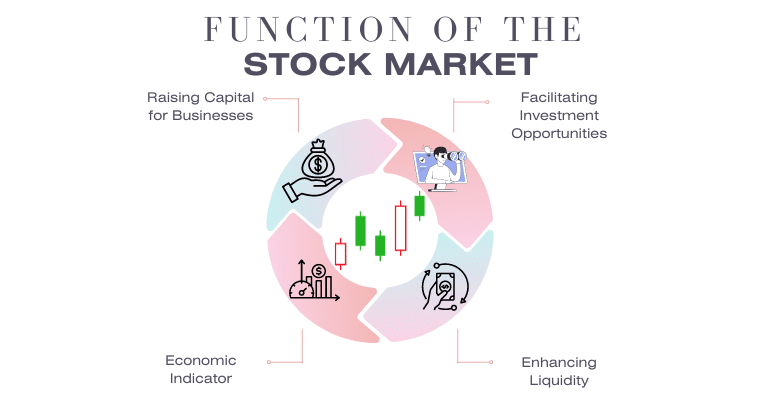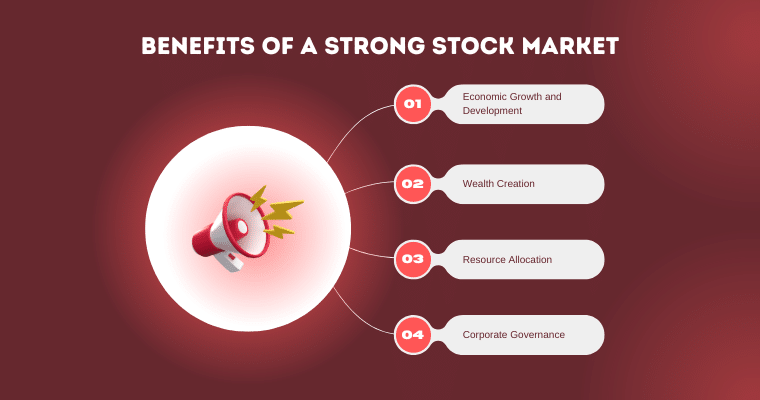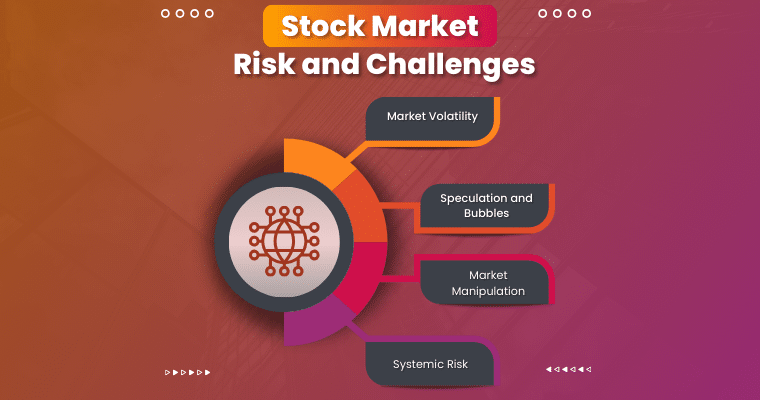The stock market is generally referred to as the backbone of the economy. This statement is very critical to any nation’s financial health and stability. This is like a gauge of economic performance, a platform for raising capital, and the means for the creation and distribution of wealth. In the following article, we will explain how the stock exchange supports the economy, its functions, benefits, and the accompanying risks.
Understanding the Stock Market
The stock market refers to the platform where the shares of companies are open to the public to buy and sell. It comprises several exchanges, such as the New York Stock Exchange, NEPSE, and NASDAQ, for trading in stocks. More simply, such exchanges offer companies ways to issue and trade stock to receive capital from investors in return for equity (Malkiel, 2003).
Functions of the Stock Market

-
Raising Capital for Businesses
One of the primary functions of the stock market is to help businesses raise capital. Companies make an issuance of shares to the public via IPO or secondary offerings. This capital is always very critical to the expansion of one’s business, research and development, and other operational activities (Bodie, Kane, & Marcus, 2014).
-
Facilitating Investment Opportunities
There is a range of investment approaches on the stock exchange for every individual and institutional investor. Here buying a share means sharing in the growth and profits of companies. It not only simplifies the process of wealth creation but also aids in the efficient allocation of resources through the flow of funds from investors to those businesses needing capital for growth and expansion (Malkiel, 2003).
-
Economic Indicator
The stock market is considered to be a leading indicator of the economy. It reflects the general feeling of all investors about the future of a particular company or the market at large. Here, infers that if the stock market is on the rise, then it presents a good sign and a harbinger of economic prosperity. However, if it is on a decline, it may act as a warning bell of economic hurdles ahead. Policymakers and many other financial analysts continuously evaluate the trends in the stock market as a measure to determine primarily the conditions of an economy (Bodie, Kane, & Marcus, 2014).
-
Enhancing Liquidity
The presence of a stock market allows for liquidity through buying and selling shares. Liquidity is essential to investors, as it would allow easy conversion of an investment into cash. High liquidity, therefore, ensures fair prices on the stock since their prices will indeed reflect their true market value when demanded based on offer dynamics (Bodie, Kane, & Marcus, 2014).
Benefits of a Strong Stock Market

-
Economic Growth and Development
A robust stock market is one of the ingredients for economic growth. It allows firms to access capital to expand and innovate. Here, in turn results in higher levels of employment, productivity, and output. The stock market also promotes entrepreneurial activity by offering a potential exit route through initial public offerings (IPO) (Malkiel, 2003).
-
Wealth Creation
The stock market offers an open window to gain significant returns, thus ensuring that wealth is created both in an individual and in an institutional capacity. It has been constituting higher returns compared to that of other assets like bonds or savings accounts over a long period for years. The effect of this newly created wealth on consumer spending and wider economic activity is overwhelming (Bodie, Kane, & Marcus, 2014).
-
Resource Allocation
The stock market enables all resources to be effectively utilized. It transfers money from people for saving to enterprises that have capital demands to expand. Through this, the stock exchange aids in transferring resources to their most promising and productive uses, hence maximizing economic efficiency and productivity (Malkiel, 2003).
-
Corporate Governance
Publicly listed companies face strict regulatory requirements and close examination. This enhances transparency, accountability, and good corporate governance in the firms. Likewise, Investors will be treated to a wealth of financial information and reports on performance, which helps them to make informed investment decisions (Bodie, Kane, & Marcus, 2014).
Risks and Challenges
While the stock exchange is associated with a number of benefits, it is also subject to risks and problems. These risks have to be understood properly in order to present protection and ensure the safety of investors, statesmen, and policymakers.

-
Market Volatility
By nature, stock prices are volatile. They move around in response to economic data, corporate earnings forecasts, geopolitical events, and market sentiment. Such volatility can result in severe losses for the poorly diversified (Malkiel, 2003).
-
Speculation and Bubbles
Excessive speculation can result in bubbles, wherein the prices of securities are inflated by irrational exuberance and not by intrinsic values. The bursting of such bubbles is renowned for causing major financial crises and economic downturns. Prominent ones include the dot-com bubble in the late nineties and the housing bubble during the mid-2000s (Bodie, Kane, & Marcus, 2014).
-
Market Manipulation
Even with regulatory oversight, cases of market manipulation and fraudulent activities can happen. These practices erode investor confidence and can result in vast financial losses. The making of sound regulatory frameworks along with potent enforcement mechanisms is principal to market integrity (Malkiel, 2003).
-
Systemic Risk
The reason that financial markets are integrated also suggests that a stock market shock will have widespread effects on the economy. A sharp decline in the stock market can trigger wealth loss, lower consumer spending, and recession. Events of the global financial crisis in 2008 demonstrated the systemic risks of financial markets (Bodie et al., 2014).
Conclusion
Undoubtedly the stock market is the backbone of any economy, which significantly plays its role in capital formation, wealth creation, and economic growth. It is one important constituent part of the financial system that must foster innovation, efficiency, and corporate governance. The functions and benefits also come along with certain risks, which must be managed with effectivity through sound investment practices and regulatory oversight.
The potential of the stock market has to weigh against its risks through cooperative efforts on the part of investors and policymakers. Among these, it is possible to ensure continuous promotion of economic prosperity and stability by the performance of the stock market.
You can also read: Top 3 Best Investing Apps for beginners
Frequently Asked Question (FAQs)
1. Why is the stock market considered the backbone of the economy?
- It is said to be the backbone of the economy because the stock market raises capital for entrepreneurs, provides them with an investment opportunity, acts as an indicator of the economy, and enhances liquidity, which is very much essential for the growth and stability of the economy.
2. How does the stock market help businesses raise capital?
- Businesses raise their capital through the issue of their shares to the public in the form of IPOs and secondary offerings. These funds would be used for expansion in R&D and other operational activities.
3. What are the benefits of a strong stock market?
- A strong stock market leads to economic growth, wealth creation, efficient allocation of resources, and improved corporate governance. Likewise, it also enables corporates to raise capital and facilitates investment returns. Not only that, it also brings transparency into a company’s performance.
4. What are the risks associated with the stock market?
- This include the volatility of the market, speculation, financial bubbles, the potential for market manipulation, and systemic risk. Unless properly contained, the factors mentioned may result in huge financial losses and economic downturns.
5. How can investors mitigate risks in the stock market?
- One can reduce the risks by diversifying the portfolio, making a proper market study, formulating long-term investment plans, and keeping updates on changes in market conditions and the behavior of the economy.
References
- Bodie, Z., Kane, A., & Marcus, A. J. (2014). Essentials of Investments. McGraw-Hill Education.
- Malkiel, B. G. (2003). A Random Walk Down Wall Street: The Time-Tested Strategy for Successful Investing. W. W. Norton & Company.





One thought on “Stock Market: The Backbone of the Economy”